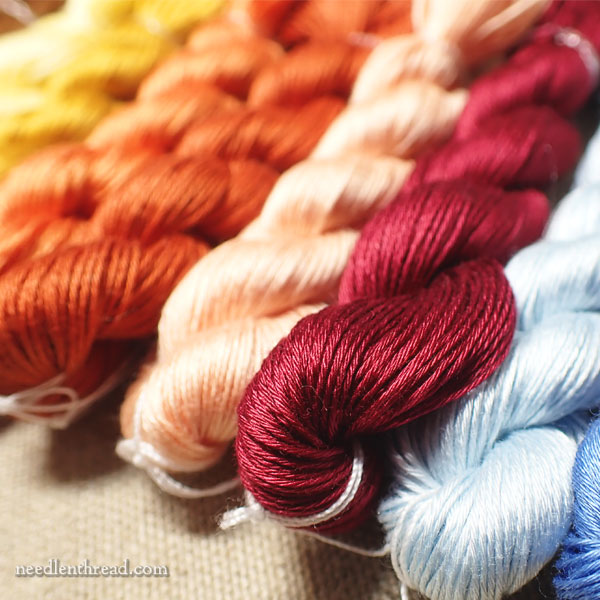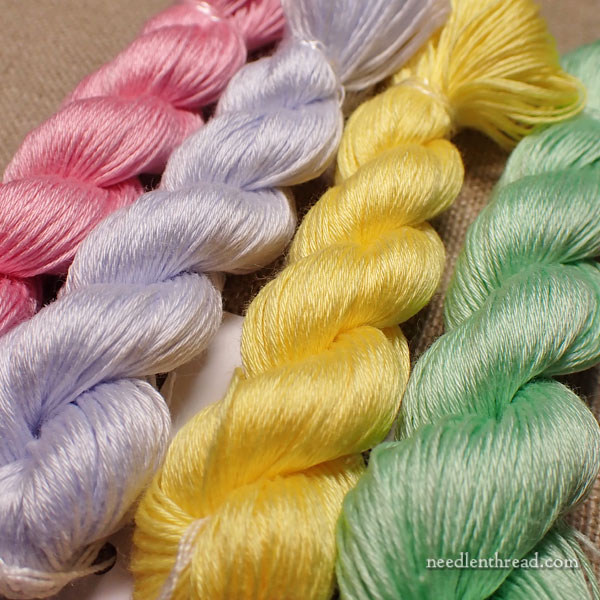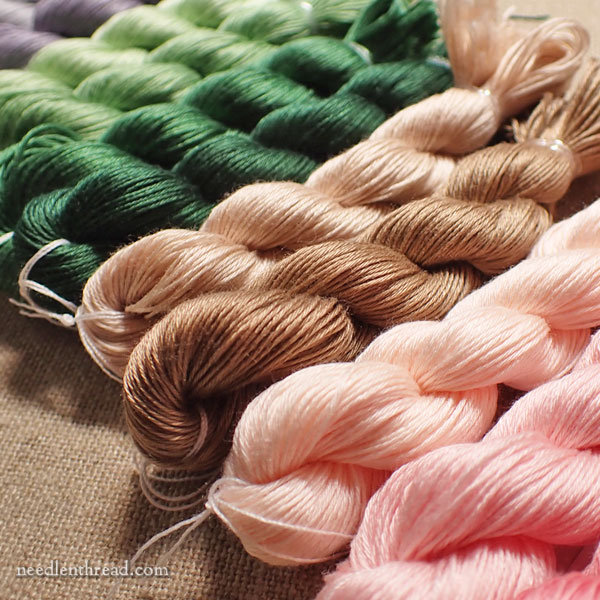Here on Needle ‘n Thread, I’ve talked a lot about cotton floche, because it’s an embroidery thread I really love.
A lot of people aren’t familiar with floche, and newcomers to our little community here may not have had the opportunity to learn about it or see what it can do as a unique embroidery thread.
I’d like to highlight some details about floche and answer the most common questions about the thread. I’ll be linking you to previous articles that will take you into further depth, if you’d like to know more. If you’ve been around here a while, this will be a little refresher, and if you’re new, it may open up a whole new world of thread for you!

Mostly, we associate cotton embroidery threads with stranded cotton, the 6-strand thread that can be separated into individual finer strands. Stranded cotton (also called “floss” here in the US) is fairly ubiquitous in the embroidery world, and I am pretty certain that most stitching folk are familiar with it.
Then, in the world of cotton needlework threads, there’s perle cotton, which is also fairly familiar and widely available. Perle cotton is popularly available in three weights: #3, #5, #8, and #12. The lower the number, the heavier (or thicker) the thread. It is a tightly twisted needlework thread that comes in a skein or a ball and is not separated before use. It’s used straight off the skein or ball, as is. The tight twist of the thread results in more texture in the stitching.
A while back, I wrote this article that compares the various cotton embroidery threads, including stranded cotton, perle cotton, floche, and coton a broder. If you’re not familiar with floche and coton a broder, the photos in the article will give you a visual comparison with more familiar threads like stranded cotton and perle cotton.
You can also read this brief guide to cotton embroidery threads for more information about cotton threads available for hand embroidery.

Like perle cotton, floche is not divided. It’s used straight off the skein, hank, or twist, without breaking it down further.
The weight (or thickness) of a piece of floche, when stitched, equals about 1.5 – 2 strands of stranded cotton, so it is a fine thread, but not as fine as one strand of stranded cotton (taken from the six).
But – floche stitches up differently, when compared to stranded cotton!
And that’s because it’s structure is different. Floche is made up of five very fine plies of soft cotton thread twisted together to make the one fine strand that you stitch with, and the twist in this final thread is a soft, rather loose twist.
The result is a thread that has a soft sort of “spread” to it, making it ideal for all kinds of stitching, but it really shines as filling stitches like satin stitch, long and short stitch, split stitch used as a filling, and the like. You can see it at work as a satin stitch filling and a split stitch filling in this monogram project here.
Nutshell: Two common questions about floche are how do you stitch with it, and do you divide it? You stitch with it straight off the skein, using the one strand, and you don’t divide it.
Because of its soft twist and the softer make-up of the thread overall, you normally use shorter strands (no more than 18″) to stitch with it, and if you notice your thread wearing or looking duller, you’d switch to a new thread (which is generally the rule with any embroidery thread).

Floche is extremely versatile. With its beautiful sheen, it is a favorite for satin stitch.
BUT… ! That’s not all!
It can be used for pretty much any type of surface embroidery. Anywhere you can use a strand or two of stranded cotton, you can use a strand of floche.
It has a softer, more visible sheen, compared to stranded cotton, and it doesn’t show as much texture in the thread itself when stitched, so it definitely has a different look compared to stranded cotton. This smoothness of texture and high sheen make it ideal for satin stitching, but it’s not limited to satin stitch!
I’ve used floche in a number of projects on Needle ‘n Thread. The most popular projects involving floche are the two in this article – the floral heart and the voided monogram needlebook in color. You can see another example of a voided monogram with floche here.
You can also use floche effectively for long and short stitch.
In the heirloom sewing world, floche is favored for decorating heirloom clothes for babies and children. It’s also used extensively in the smocking world. You can see the details of embroidery in this first communion dress that my sister made ages ago for her children, using heirloom sewing techniques and using floche for the embroidery.
Nutshell: What kind of stitching do you do with floche? Floche works well with all kinds of surface embroidery techniques. It’s also used for smocking, monogramming, heirloom embroidery, and even counted work.
Where to Find Floche
Although floche is made in France by DMC, it is only distributed through a company in the US because that’s where the thread has retained popularity in the market over the years. There are some shops abroad that import the thread, so ask at your favorite needlework shops.
The other point worth noting about about floche its 93 colors are put up in Massive hanks, which makes it pricy to build a good collection of colors. Here at Needle ‘n Thread, we break the hanks down into smaller twists (of 50 yards), so that you can acquire a good selection of colors more affordably.
We have four collections available in the shop right now, if you are keen to try this thread.
One is the Garden Bright collection, which features all the colors I used for the Floral Heart project and the voided monograms. This collection contains 20 colors of floche in 50 yard twists, with the threads pre-cut to an 18″ stitching length.
We also offer to Heritage collections – Heritage Warm and Heritage Cool. These collections are made up of 12 colors of floche in 50 yard twists, with the thread pre-cut to 18″ stitching lengths.
And finally, we offer mini collections, which are taster packs of four colors of floche in the same 50 yard twists. Right now, the mini collection that we have available is called Spring Frost, featuring four light, soft, frosty spring colors.
There are no repeats in color between the Heritage collections and Spring Frost, so they are a good way to start building a good array of colors to work with.
If you have the Garden Bright collection, there are three colors repeated from that collection, one in each of the Heritage and the Spring Frost Mini collection. This couldn’t be avoided. The Garden Bright pack has a wide array of colors and shades specifically selected for the floral heart and voided monograms projects.
We’ll continue to expand the floche color collections this year, and we’ll work hard to keep them in stock. We are at the mercy of the supply chain, though, so we’ll be working with what we can get, when we can get it.
If you have any specific requests for floche colors or color schemes, feel free to reach out!







Do you have any vendors who do other colors. I have been using this for tea towels I’m stitching for Christmas gifts. I notice that there is a no turquoise in floche. I also had a hard time with med dark blues.
Floche is limited to 93 colors, unfortunately. I don’t have all of the colors yet, but I plan to eventually. You can check Vaun dot com – I know she carries the whole range of floche.
I tried going to http://www.vaun.com, but was blocked by my browser. Any suggestions?
Well, there’s not much to do about that. I know it’s a legit website. But if her certificate isn’t up to date – or if she doesn’t have one – then you’ll likely get warnings on your browser, depending on your browser’s security settings.
Are you sure the URL isn’t
https://www.vaune.com
rather than “vaun”? My browser gets to that URL successfully, and I think this must be the site that Mary means, because it has allllll the floche in the shop!
I believe the correct Web site is http://www.vaune.com (with an e).
It is Vaune don’t forget the ‘e’.
She also has sets of floche that go with Mary’s monograms and alphabet patterns.
“This smoothness of texture and high sheen make it ideal for satin stitching, but it’s definitely limited to satin stitch!”
I think you meant to write “it’s definitely *not* limited to satin stitch” there. ☺️
Corrected it, thanks! 🙂
As always, great article. I always like the information and as well as your writing style – as though you were talking directly to each of us readers.
Thought you would want to correct this typo: ( This smoothness of texture and high sheen make it ideal for satin stitching, but it’s definitely limited to satin stitch! ) “but it’s definitely limited to satin stitch!” I think should have “not” inserted before “definitely”.
Thanks! Got it! 🙂
Another lightning-fast and fully satisfactory shipment from Needle’nThread: ordered floche Thursday, received it on Saturday, it looks great! Now I really have to pore over my embroidery project wishlist and see what to make with all this wonderful stuff!
Hi, Mary!
Would you please compare floche with Retors d’Alsace? Retors d’Alsace is similar to Ritorto Fiorentino (both available only in Italy, I believe) and pearl cotton, correct?
Hi, I would like some advice about what size/type of needle to use with floche? I’m using it in a project now and am having problems. Needles which have a big enough eye, are too big for the stitches I want.
Thank you for a fantastic website
Hi, Sally – a #7 or a #8 crewel works well with floche. Hope that helps!
Me ha parecido maravilosa esta pagina. Yo por desgracia he empezado a hacer Patchwork hace poco al jubilarme y me encantaria arender a bordar puntos sencillos para decorar. ¿Tienen clases por Internet) si es asi me gustaria me informaran para ver si me puedo apuntar. Gracias. JUANA
Hello, Juana, I do not have classes online at this time. I do offer some free stitch-alongs on the website, that you can follow along with. We are starting one next week. Thank you for reaching out! I hope you are enjoying your retirement!